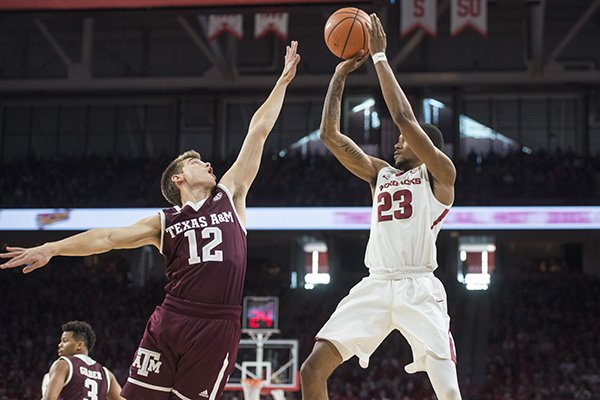LITTLE ROCK — Sooner or later, euphoria created by Daniel Gafford’s delivery of Arnold Schwarzenegger’s oft-repeated movie line will be replaced by the realization of an identity crisis.
Gafford’s somewhat surprising “I’ll be back” for a second year dramatically altered expectations for Arkansas basketball next season and increased the onus on coach Mike Anderson to get the Razorbacks past the opening weekend of the NCAA Tournament for the first time since 1996.
Although talented with a splendid future, the 6-foot-11 Gafford can’t do it alone and his announcement prompted a look at Anderson’s ballyhooed 2018 recruiting class in an attempt to identify potential 3-point shooters. Four of the six freshmen-to-be are guards who are touted as scorers, but scorers and athletes proficient from beyond the arc aren’t necessarily the same.
Described by Anderson as the centerpiece of the team, Gafford will improve offensively, maybe develop a short jumper or a reliable baby hook. After all, as a freshman, 74 of his 164 baskets were dunks. Once Gafford establishes an expanded repertoire, opponents will collapse on him and dare his teammates to make 3s.
The question is: Who?
Seniors Jaylen Barford and Daryl Macon attempted 403 of Arkansas’ 3s and made 172, a solid 42-plus percent. The rest of the team took 276 3s, including 116 by senior Anton Beard, and made less than 35 percent.
Good at times, C.J. Jones shot 116 of the team’s other 160 3s and made 37.1 percent, but he was also 0-of-16 against 11 SEC opponents.
Clearly, there is a void, but 3-point shooters in high school can step back 12 inches from the 19.75-foot line and be equally proficient in college.
Stats compiled during the senior year of Arkansas’ incoming guards:
—Isaiah Joe, Fort Smith Northside, averaged 22.8 points per game, making 38 percent from 3-point range. The school’s all-time leading 3-point shooter, according to coach Eric Burnett.
—Keyshawn Embery, Midwest City, Okla., 46 percent from the field, 36 percent on 76 3-point attempts.
—Desi Sills, Jonesboro, averaged 19.8 points per game, making 62 percent of his 2-point attempts and 33 percent of his 3s, after hitting 42 percent and 41 percent from long range his first two years. Defenses dedicated to Sills are the logical explanation.
—Jordan Phillips, Arlington, Texas, 21.1 points per game, 45.7 field goal percentage, but only 25 percent on 3s.
Like it or not, use of the 3-point shot is more a part of the college game each year.
After the 3-point line was extended a foot to 20.75 for college players prior to the 2007-08 season, there was a brief lull in 3-point attempts and only 31 percent of all shots were from long range in 2009 and 2010.
Since then, the trend is strictly upward — from better than 32 percent in 2011, to more than 35 percent in 2016, to 36.4 last year and 37.4 this year, according to kenpom.com.
Part of the impetus occurred in 2016 when the shot clock was reduced by five seconds, and NBA players shooting from way outside is an influence.
Shooting 3s is not a strategy reserved for the desperate — Final Four teams Villanova, Kansas and Michigan averaged 28.7, 25.1 and 24.5 3s per game.
Arkansas was No. 264 in the country with 19.5 attempts per game.
Not only are college players attempting more 3s, they are connecting on better than 35 percent this year. In response, the NCAA experimented with moving the 3-point line back 20 inches during the NIT. Despite that, four teams in the tournament quarterfinals made more than 40 percent of their 3-point attempts and two other teams hit 38 percent.
Advancing to the finals, Penn State made 11 of 20 attempts. The Nittany Lions and Utah each made better than 40 percent in the championship game.
The Razorbacks must make 3s to be the SEC contender that fans perceive them to be with Gafford in the lineup.

